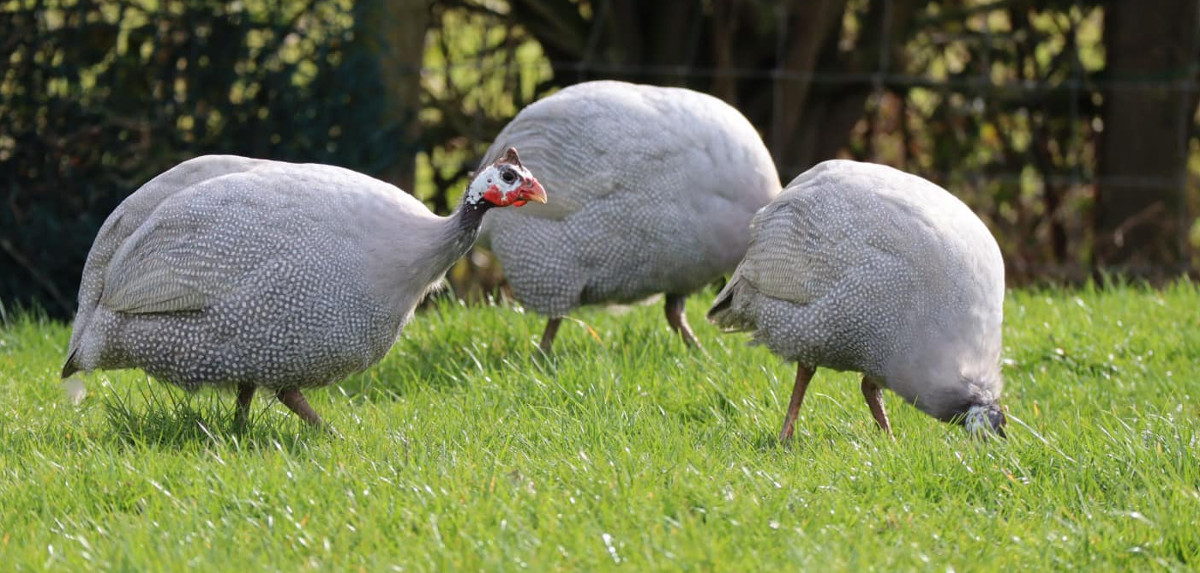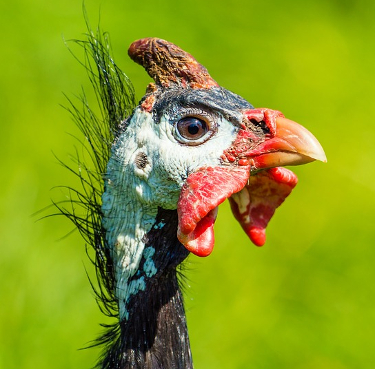Before you get Guinea fowl.

So what do I wish I knew before I got my Guinea fowl?
Guinea fowl, often referred to as guineas, are game birds that are increasingly popular among keepers of small and backyard flocks. They are delightful but hard work.
Guineas are vigorous, hardy, and largely disease-free birds known to be relatively long-lived. Sometimes 10-15 years if they can avoid being eaten especially as they are not the smartest birds out there.
There are a few things I wish I had know about guineas before I started keeping them. Think with care a while before you decide to get Guineas. Although the eggs are amazing to eat, especially poached they are not productive layers as such and are a labour of love rather than a money maker although you can profit from them.
Below: Guinea fowl are pretty to look at but they do require planning.

The other funny thing about Guineas is that if they see you taking their eggs they will move the nest. And you will be surprised how much hunting you need to do to find them.
Feeding, housing, breeding practices and legislation is all slightly different and even if you can have chickens you may not be allowed other poultry types. Also plan an exit strategy if it doesn't work out keeping guinea fowl.
Preparations before starting a flock:
Before starting a flock you must check local zoning regulations and laws to make sure that raising poultry is allowed and in what numbers.
This is particularly important when raising guinea fowl because they will range and cross the boundaries of a small lot.
Guineas are not quiet birds by nature and they can be very noisy if disturbed. Guineas are more active than chickens and not as easily tamed. They always retain some of their wild character.
You chickens will naturally go to roost at night whereas Guineas are very independent and single minded and not easily tamed.
There are many reasons to raise Guinea fowl. The birds sound an alarm whenever anything unusual occurs in their vicinity. Some people find this noise to be a nuisance but others find it to be an effective tool for protection.
The loud noise and appetite of the Guinea has also been shown to discourage rodents from invading the area.
Guinea fowl can be used to control insects. Wild guineas eat mainly insect swill happily hoover up any they find. Guineas can reduce risk of Lyme disease by consuming ticks which carry the disease. They do not have the same effect on gardens, vegetables or flowers that flocks of chickens do for example.
Guinea fowl can also be raised for meat production. The meat of young guineas is tender and tastes like that of wild game.The meat is lean and rich in essential amino acids. Guinea eggs can be eaten just like chicken eggs.
Take a look at our Guinea fowl basic equipment list before you start.
Guineas and noise:
Guinea fowl are noisy birds, not only making a lot of noise but they are loud.
There is no real way to keep guinea fowl quiet and I suggest you don't waste time trying. There is an advantage of Guineas in that the males don't crow like chickens do.
If something disturbed Guinea fowl at whatever time it is they will make a load alarm call that can go on for ages, this is why they are sometimes used as "guard Guineas".
Housing:
Guinea fowl are often left to fend for themselves, but it is best to provide some sort of shelter to protect them from weather and predators. The shelter can be bought, purpose-built or a room allocated in the barn. It takes a great deal of time to teach guineas where home is, often 30 days or more.
If you want to keep your guineas from wandering in a specific area, you must keep them in covered pens. Guineas are able to fly at a very early age, and they become strong flyers easily able to fly 500 ft or more.
Anybody who has ever tried to catch one will tell Guineas are agile and fast runners and prefer to move on foot even when evading predators.
Under most conditions, you should not confine male guineas with chickens if there are roosters in the same flock unless they have all grown up together. When male guineas are housed with roosters full-time the guineas see it as amusing sport to harass and chase the cockerels and can keep them from food and water.It is perfectly fine to keep guineas and roosters in the same area if they are free range.
If you are keeping guineas for egg production you should provide nest areas. Nest boxes designed for chickens are not acceptable to guineas. They prefer a shallow depression in the ground. Mine scrape hollows in the coop floor and I long ago gave up trying to get them to use a nest box. they like to be able to see around them.
Keeping guinea hens confined to a hen house until noon each day so that they will lay eggs inside will reduce the likelihood of hens laying eggs in hidden nests outside.
Bird selection and purchase:
Keets are guinea fowl offspring that are younger than 12 weeks old. If you wish to start with day-old keets, you can buy them from a local breeder or feed mill but they are not common or always available and you may need to order them or travel.
If you are buying keets check they are happy, clean (especially around the vent), Bright eyed and mobile.
If you are buying older birds check the same things but have a look at the legs to make sure you are not being sold old birds.
Think about feeding and nutrition:
Guineas need a higher protein feed than chickens especially when young, but do quite well on regular poultry diets when fully grown if allowed to free range.
Keets need a 24% to 26% protein ration as the starter feed for the first 6 to 8 weeks. The protein level should be reduced to 18% to 20% for the next 4 to 6 weeks and after 12 to 14 weeks the young guineas will be fine on layers or poultry feed.
If your feed mill does not sell feeds in the proper protein levels, you can mix a higher protein feed with a laying-hen mash to get the proper protein level. Guineas should be fed small pellets, mash or crumbles.
Standard size layer pelleted feed is not recommended for guineas. Mine ignore it completely and prefer a seed based feed.
Adult guineas forage for themselves and are able to meet most of their nutrition requirements on their own.
Guineas need to consume some greens in order to maintain good digestion, and so they eat grass, dandelions, weeds, and other vegetation. Because the birds are consuming vegetation, it is important to make sure grit is available for the birds, and the birds also benefit from having oyster shell available.
Provide clean water at all times.
Guineas do enjoy a little scratch feed on the ground. They like most grains and seeds.
If you are keeping the guineas for pest control, restricting their feed a little especially in the mornings will encourage them to spend more time eating insects. Feed as normal in the afternoon and evening as this is part of their training to keep the coming home.
If for any reason guinea fowl are not allowed to forage, they can be fed a commercial poultry diet. Medicated or unmedicated feed is a personal choice that seems to make little difference with guineas.
You should also provide supplemental greens, such as leafy alfalfa or sprouts for the guineas to peck at. They will eat the leaves. It is important to remove any leftovers daily to prevent a mould problem.
Hatching your own keets:
In the wild, guinea fowl mate in pairs. This tendency also exists among domesticated guineas if there are equal numbers of males and females.
As the breeding season approaches, pairs of Guineas will wander off in search of hidden nesting sites.
It is not necessary, however, to have equal numbers of females and males to obtain fertile eggs. For most flocks, one male is usually kept for every four to five females. When Guineas are kept in close confinement, one male may be mated with six to eight females.
Guineas usually start laying in March or April and may continue to lay until October. A hen from a carefully managed flock may lay 100 or more eggs a year.
Breeders generally produce well for at least three years and lay for four to five years.
In nature she would lay 20 to 24 eggs and then go broody.
The incubation period for guinea eggs is 26 to 28 days, similar to the incubation period for turkeys.
The preferred method is to use broody chickens can be used to hatch Guinea eggs. A bantam chicken hens can sit on 12 guinea eggs, while a large chicken hen can sit on 20 to 28 guinea eggs.
Guinea hens can be but are not always make good mothers. Chicken hens tend to be much better mothers and a large chicken can brood up to 25 Guinea keets.
When allowed to incubate eggs naturally, Guinea hens normally do not go broody until the nest has around 30 eggs and communal nest with 3 or more hens is not uncommon.
Guinea eggs are smaller and have thicker shells than chicken eggs but are light in colour and relatively easy to candle. Incubating guinea eggs is similar to incubating chicken eggs except for the extra 7 or so days and the temperature should be 99 F or 37.4C, a little lower than chicken egg
Will you be brooding and rearing your own Guineas:
Damp and cold is the biggest killer of young guinea fowl chicks, they easily get into unsuitable waterers and get wet. Brood them on sand and use small necked water containers, the red and white plastic types you buy cheap from poultry suppliers are no good.
Guinea fowl are native to Africa, and as such, are very susceptible to dampness during the first two weeks after hatching. The moisture keets encounter when following their mother through dew laden grass in early mornings can kill them. I consider Guineas the hardiest of all domestic fowl I have raised.
Keets can be raised in the same type of brooder houses and brooders as chicks or poults (baby turkeys). Temperatures should be started at 95°F for the first week or so after hatching and then lowered by 5°F per week thereafter. Keets have better control of their own body temperature thanks to the extra week in the egg and prefer a brooder with a hot spot and a cool spot
Infrared lamps are a convenient, easy-to-use heat source for brooding. Make certain lamps are secured properly so they cannot fall to the litter and create a fire hazard.
